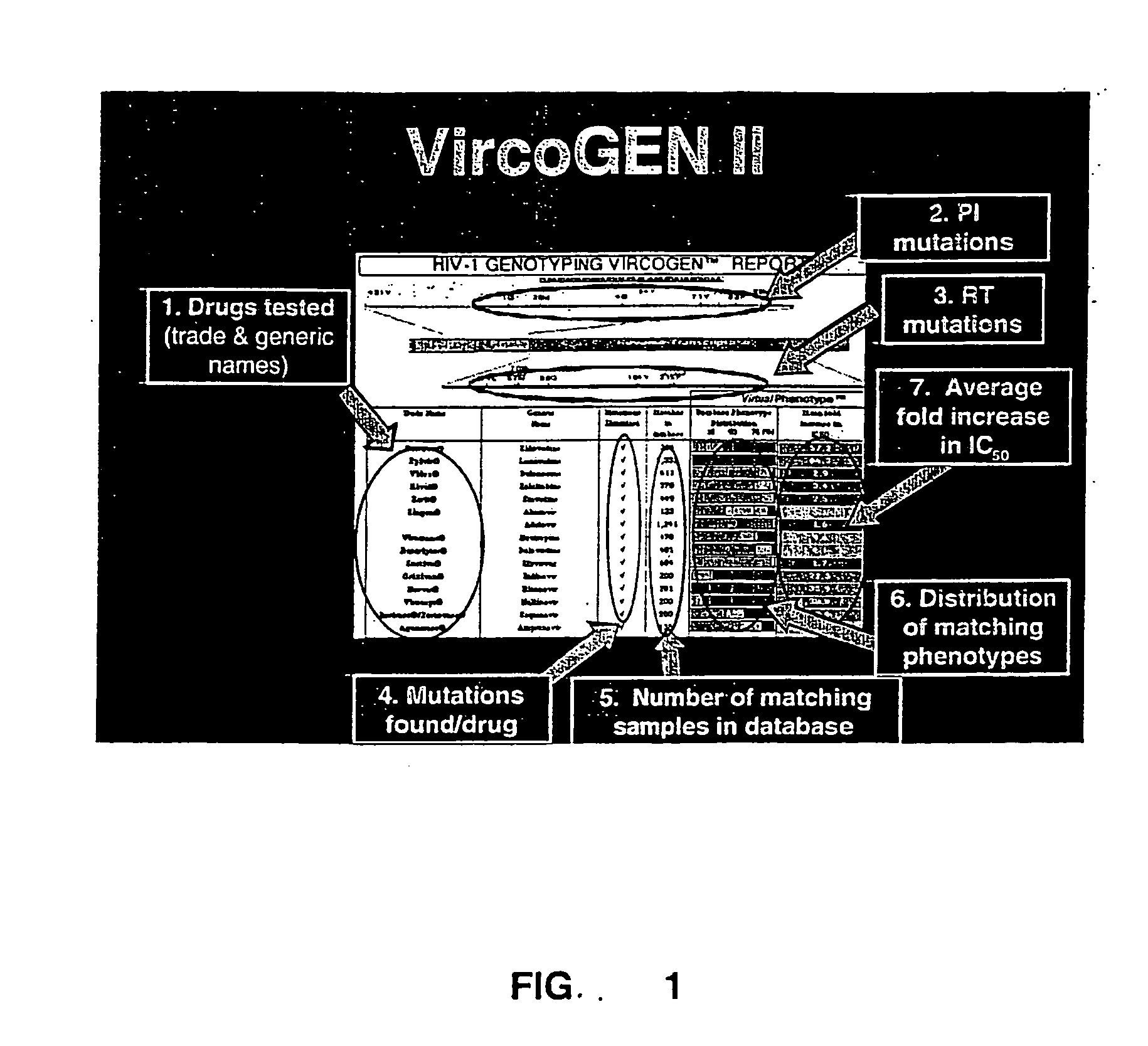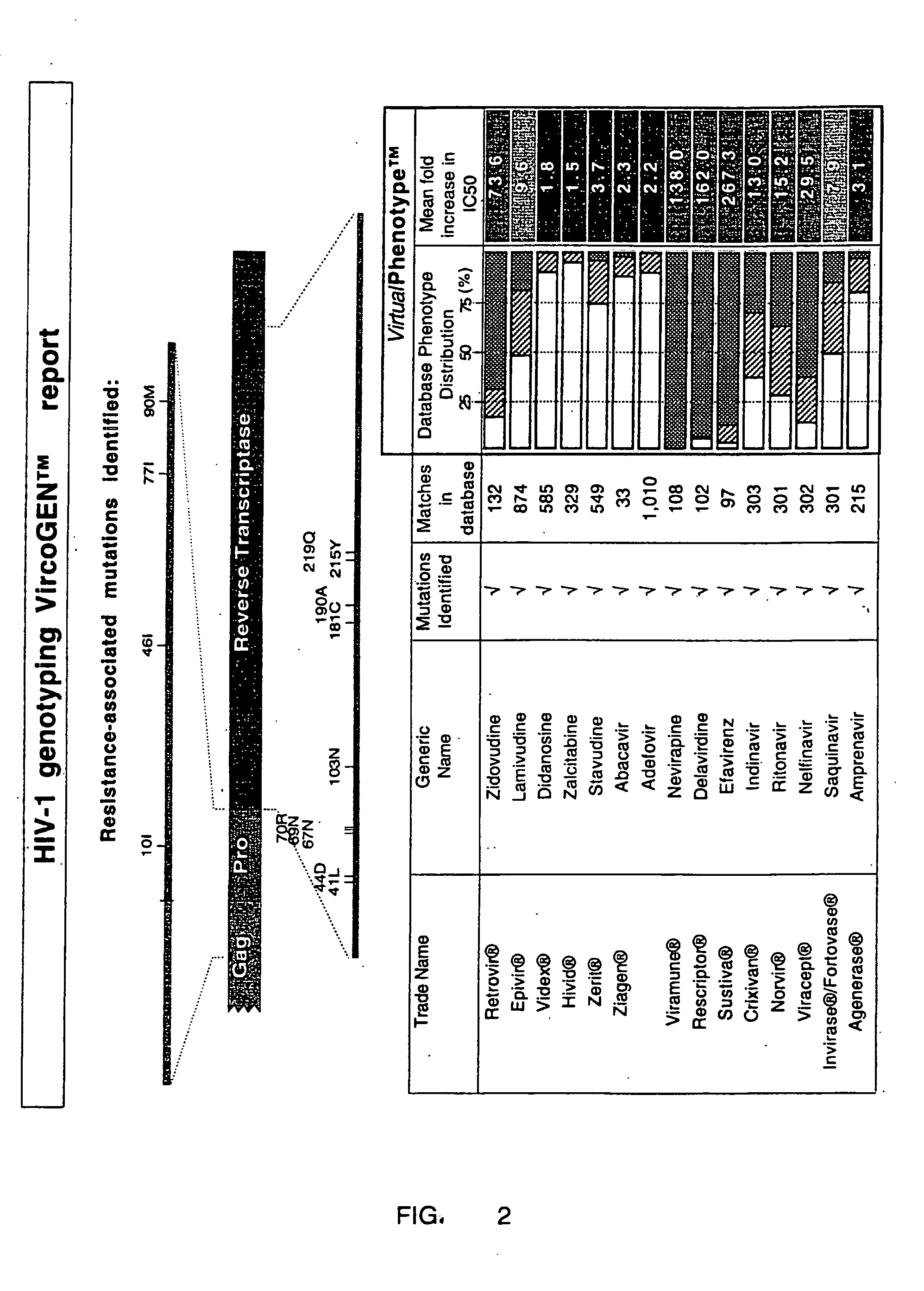Method for measuring drug resistance
a drug resistance and measurement method technology, applied in the field of measuring drug resistance, can solve the problems of drug resistance, many patients experience treatment failure or reduced efficacy, and all the compounds lose their effectiveness over time,
- Summary
- Abstract
- Description
- Claims
- Application Information
AI Technical Summary
Benefits of technology
Problems solved by technology
Method used
Image
Examples
example 1
[0199] Definition of a Sequence.
[0200] A sequence consists of a number of nucleotides. Nucleotides are represented by the letters A, C, T and G. A, C, T and G are the bases of a sequence. Other letters like R, Y, M etc. stand for a combination of two or more bases.
3 Letter MPX Letter MPX R AG H ACT Y TC B GCT M AC V ACG K GT D AGT S CG N GATC W AT
[0201] Groups of 3 nucleotides form a codon. These codons are translated to amino acids and then compared to a reference sequence in order to determine the mutations. A mutation is a difference between the reference sequence and the test sequence. The raw nucleotide reference sequence looks like this (the example shows only the protease section which contains 99 amino acids or 297 nucleotides. The `reverse transcriptase` section contains 400 amino acids or 1200 nucleotides.):
4 CCTCAGGTCACTCTTTGGCAACGACCCCTCGTCACAATAAAGATAGGGGG GCAACTAAAGGAAGCTCTATTAGATACAGGAGCAGATGATACAGTATTAG AAGAAATGAGTTTGCCAGGAAGATGGAAACCAAAAATGATAGGGGGAATT GGAGGTTTTATCA...
example
[0210]
7 Drug A Mutation A .vertline. Mutation B .vertline. Mutation C .vertline. Mutation D Mutation E .vertline. Mutation F Mutation G & Mutation H (Mutation I .vertline. Mutation J) & (Mutation K .vertline. Mutation L) Mutation M .vertline. Mutation N .vertline. Mutation E .vertline. Mutation F (Mutation M .vertline. Mutation N .vertline. Mutation E .vertline. Mutation F) & Mutation G Mutation O & Mutation P Mutation Q .vertline. Mutation R .vertline. Mutation F Mutation E & Mutation Q & Mutation G Mutation R
[0211] In this example, there are 10 hot spot descriptions related to the drug in question.
[0212] To compare the sequences, a list of profiles (one profile per drug that is tested) is determined for every sequence. The profile is determined by keeping count of matching and non-matching hot spots per drug.
[0213] In the above example, if a sequence would match hot spot 2, 5, 6, 7 and 9, the sequence would have a profile for this drug equal to `0100111010`. Every new profile is s...
example 2
[0221] One example of an embodiment of the present invention can be described by the following steps:
[0222] 1. The gag-RT-PR sequence is entered into a computer as a text string;
[0223] 2. The computer program scans the sequence for all mutations, and `lists` all those that are known or suspected to play a role in the development of drug resistance;
[0224] 3. The mutations are then listed against each of the drugs for which they affect sensitivity;
[0225] 4. For each drug, the computer program interrogates a genotype database for previous samples with the same or similar mutations or sequences, relating to that drug. Primary mutations, those initial mutations that have a discernable effect on drug resistance, are searched in the database individually first. Secondary mutations, those that have subtle effects on resistance or increase viral fitness, are searched in groups. Typically there will be several hundred records that match the pattern of mutations for each drug;
[0226] 5. Every t...
PUM
| Property | Measurement | Unit |
|---|---|---|
| resistance | aaaaa | aaaaa |
| fold resistance | aaaaa | aaaaa |
| drug resistance | aaaaa | aaaaa |
Abstract
Description
Claims
Application Information
 Login to view more
Login to view more - R&D Engineer
- R&D Manager
- IP Professional
- Industry Leading Data Capabilities
- Powerful AI technology
- Patent DNA Extraction
Browse by: Latest US Patents, China's latest patents, Technical Efficacy Thesaurus, Application Domain, Technology Topic.
© 2024 PatSnap. All rights reserved.Legal|Privacy policy|Modern Slavery Act Transparency Statement|Sitemap



